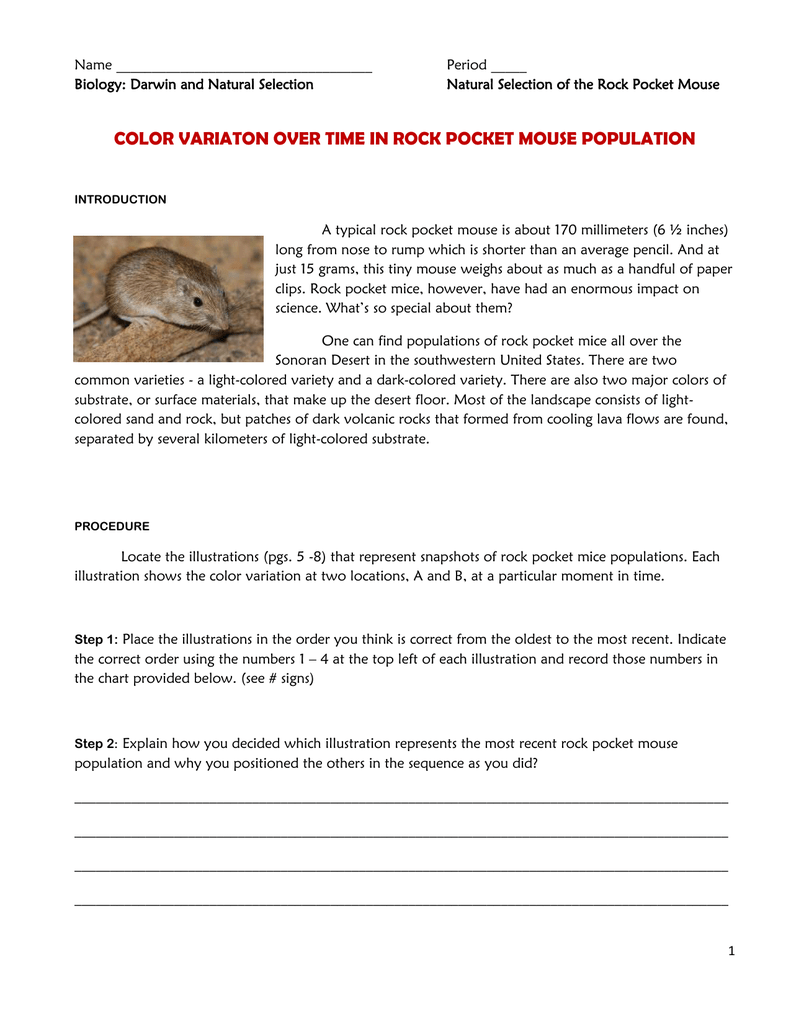

Manage saved and uploaded resources and foldersīrowse educational resources by subject and topic The trait is inherited (passed from parents to offspring).Search reviewed educational resources by keyword, subject, grade, type, and more Variations can be physical features, behavior, bodily functions, or resistance to disease. Individuals in a population differ in some trait. Use what you have learned in the activity and the film we watched on rock pocket mice. **Other Animals that Model Natural Selection - For discussion in ClassĮvolution by Natural Selection - VIDA Chart - In the evidence section, write a list of ways in which the rock pocket mouse illustrates the idea posed in the description. Hint: those features might help them do other things. Suggest a reason for traits that don’t help an animal survive. Sometimes animals have traits that don’t seem to make sense, like the long tail feathers of a peacock. How do predator species in the desert survive? What adaptations do they have to make them good hunters?ĥ. Predators must be able to obtain food and overcome the defenses of prey. What are other types of defenses that prey species might use?Ĥ. Animals develop many types of defenses to avoid being eaten.

What happens to organisms that have adaptations that no longer work for their environment?ģ.
ROCK POCKET MOUSE WORKSHEET SKIN
Based on this hypothesis, where do you think more darker skinned people lived? Suggest a reason why light skin may be an advantage for people living in other regions.Ģ. One hypothesis is that dark skin protected humans from intense UV radiation (sunlight). Human skin color also comes in different shades. Consider the dark and light colored rock pocket mice. How did you revise your sequence from your initial idea? Explain how you decided on the sequence.ġ. Once you are satisfied with the order, complete the table.Ĩ. You may change your order from your original idea. Now that you have watched the video, go back to your set of cards and arrange them in the order you think they happened, starting with the oldest. Genetics revealed what surprising fact about mice in different locations?ħ. Dark pocket mice are found in locations that have dark substrate.

They have a genetic mutation that affects their fur color.There is dark lava rock in the area where they live.Individuals change color to blend in with the environment.Why did dark-colored rock pocket mice first appear in a population of light-colored rock pocket mice? Predators of the pocket mice hunt using what sense?ģ. How caused the unusual landscape at the Valley of Fire?Ģ. Watch the video at /rockpock and answer the questions.ġ. What are the two types of substrate that these mice live on? _.Arrange the cards in what you think is the correct order from the oldest to the most recent.Location B: Number of mice with light-colored fur _ Dark-colored fur _ Location A: Number of mice with light-colored fur _ Dark-colored fur _ View the images of the rock pocket mouse populations in each location and record the numbers for each color.Most of the landscape consists of light-colored sand and rock, but patches of dark volcanic rocks that formed from cooling lava flows are found, separated by several kilometers of light colored substrate. There are also two major colors of substrate, or surface materials that make up the desert floor. There are two common varieties-a light-colored variety and a dark-colored variety. You can find populations of rock pocket mice all over the Sonoran Desert in the southwestern United States. And at just 15 grams, this tiny mouse weighs about as much as a handful of paper clips. \)Ī typical rock pocket mouse is about 170 millimeters long from its nose to the end of its tail, shorter than an average pencil.


 0 kommentar(er)
0 kommentar(er)
